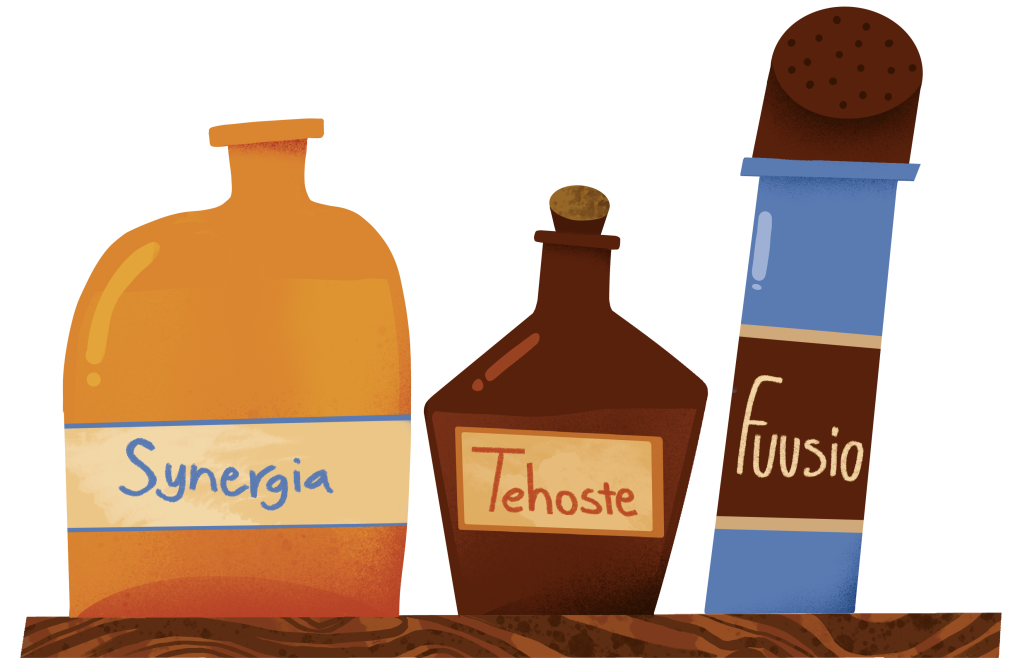Two higher education institutions operate on the Linnanmaa campus: the University of Oulu and the Oulu University of Applied Sciences (Oamk). Oamk’s relocation to Linnanmaa was decided on at the end of 2016 and teaching in the renovated facilities began during 2020. The northern parts of the Linnanmaa campus became home to Oamk’s engineering, natural resources, culture, and business studies. Healthcare studies stayed at the Kontinkangas campus.
The arguments for the relocation included shared facilities, services, and teaching co-operation. In Kaleva’s news article in 2018, Jouko Niinimäki, the rector of the University of Oulu, painted images of future possibilities: ’by developing co-operation we could create an internationally charismatic community of science, education, and innovation.’ In 2021, a year after the relocation, Heidi Fagerholm, the vice rector of Oamk, enthused about the future in an announcement published by the University of Oulu, saying that ‘in principle, a student can enroll on any course as long as the admission requirements for the course are met and the course has the free space.’
‘It requires a large amount of work from both higher education institutes’
How have the joint studies been going then? Browsing through the study guides, the catalogue of cross-institutional studies is very diverse and it looks different for every faculty and field of study. Cross-institutional studies mean courses or study modules that are open for the students of both institutes of higher education. For instance, in the Faculty of Biochemistry and Molecular Science there is no active course offering due to a lack of demand, but according to Tuomo Glumoff, the dean for education, the institutions are open for co-operation if the offered studies included a course suitable for the students of Oamk. On the other hand, the Faculty of Information Technology and Electrical Engineering offers so many cross-institutional courses that if they all are counted together, they are worth a whopping 260 credits.
In this dual model, Oamk’s supply for the other party is quite limited. They have a few dozen courses to offer. For example, the study guide does not include any cross-institutional courses from the fields of engineering or natural resources. Business economics offers study modules only regarding entrepreneurship. Most of the courses are offered as online versions, which, on a positive note, enable more flexible completion of courses.
Both institutions of higher education offer studies from the fields of healthcare and social services, engineering, and communication, so some common fields surely exist. The Oulu Student Magazine reported on education co-operation in 2020. Back then, the fields of engineering (architecture and civil engineering), information science, and business were mentioned as possible fields for co-operation.
‘There has been little collaboration on the curriculum level, except for a few individual study units’, says Jyrki Laitinen, the vice rector of Oamk. ‘In this regard, the initial aim was to build flexible study paths to facilitate transitions from one sector to another after getting a bachelor’s degree, which would bring new kinds of opportunities for students. This requires a large amount of work from both institutions of higher education. It remains to be seen if this will happen in the next few years.’
Satu Nätti, the dean for education of Oulu Business School, says that the coronavirus pandemic is one of the reasons for the lack of co-operation: all resources were simply spent on coping with the change in the educational situation. The situation has now returned to normal, but the discussions regarding co-operation haven’t been newly kicked off yet. ‘The important thing, of course, is that a person who has graduated as a Bachelor of Business Administration has the right to apply directly to our Master’s Degree, and many people with such a degree who have wanted to continue their studies have utilized this opportunity.’
Jere Tapio, the specialist of academic affairs of the Student Union of the University of Oulu (OYY), also thinks that closer education co-operation is still an untouched topic. ‘I have acted in various educational bodies for the last year. Only a few of the discussions have dealt with questions on how to benefit from the neighbouring institute, but all concrete actions have mainly been seen only in the education service units.’
Cross-institutional studies also have practical issues. For instance, 250 freshmen begin their studies annually at the Oulu Business School. According to the education dean Nätti, it is challenging to organize systematic, mutually beneficial cross-institutional studies for such a large number of students. ‘How we could get real benefits out of this, for example saving on education resources without making the number of students per group absurd, is a good question.’
According to vice rector Laitinen, there are ways to make close co-operation possible. ‘Shared campuses or the proximity of campuses, shared services, and high-quality course selection support co-operation. Both higher education institutions are multidisciplinary by nature so finding equivalent programmes is easy.’
The University of Oulu became the chief shareholder of Oamk in 2018. Shared services for the both institutions include for example the library and information management.
Besides joint facilities and studies, the University of Oulu and Oamk collaborate on research, development, and innovation activities (RDI). Laitinen mentions that on the RDI side, external funding is pushing them towards co-operation. For example, projects funded through the European Union’s regional and structural policy programmes are often carried out in co-operation between several higher education institutions and other organizations.
Nätti also mentions EU-funded development projects as a functional form of co-operation. ‘Intensive co-operation was done in the Myski project, for example. Several joint projects related to female entrepreneurship and leadership have also been conducted.’ The Sales expertise as the core of growth (Myski) project, led by Oamk, was implemented in 2019 – 2022 and, among other things, it aimed to better the sales expertise of the staff of both institutions.
Strategic development requires resources
In practice, higher education institutions do things that they will be measured on and things that they are paid for. The funding model of the Ministry of Education and Culture (OKM) does not really reward cross-institutional studies, so it is quite understandable that individual faculties and institutions are not too enthusiastic about developing them. There also are not that many statistics available on cross-institutional studies. The education services of the university do not directly collect data on cross-institutional studies, and even in the statistics service of the Finnish National Agency for Education (EDUFI), all teaching co-operation is lumped under the same, ‘inter-university co-operation’ category.
In fact, Laitinen states laconically that the financial incentive is quite limited at the moment. ‘What comes to education, the financial motive comes mostly from the funding model of the OKM in which the importance of collaborative studies is very low. In our case, the motive might be student orientedness, that is, increased study opportunities.’

With the digital transformation, the higher education study offerings are also in quite a turmoil. The Digivisio 2030 project invites higher education institutions to think in a new way. It is therefore not necessarily sensible to develop local operating models because the national project might soon send differing instructions to guide the operations.
According to Tapio, the specialist of academic affairs, the Digivisio project aims to gather studies onto a platform called opin.fi, which would include open course offerings from all universities. In the future, a study module of 25 credits that consists of five courses could be offered so that each of the courses is offered by a different university. Laitinen also mentions the opin.fi platform. ‘Most likely from 2025 onwards supply will be moved to that platform.’
However, Moodle, the joint learning platform of the higher education institutions of Oulu, is one of the options to develop. ‘Moodle is developed in close collaboration. Going forward this platform could make it more flexible for students to view and move between different institutions and their study offerings’, mentions Laitinen.
Is it more natural for higher education institutions to seek partners from far away? Tapio from OYY thinks that co-operation between some degree programmes might be easier with a similar higher education institution that is further away than with another institution that happens to be nearby.
Satu Nätti agrees with Tapio. She mentions that the AACSB quality assurance system, which Oulu Business School has in place, slows down co-operation. Oulu Business School cannot ensure the same accreditation for teaching outside of their faculty. ‘Basically, in this sense the best co-operation partners are other accredited schools that operate within the same quality assurance system. We are trying to develop, for instance, international exchanges with such schools’, says Nätti.
The money appointed to strategic development is scarce, and developing co-operation would possibly demand long-term work. Laitinen also mentions that there really isn’t any pressure to increase the amount of cross-institutional studies. ‘Universities of applied sciences offer a wide selection of CampusOnline studies on a joint agreement.’
Besides funding, motivating staff for changes is also a challenge. ‘Situations in which we let go of something that we already have and replace it with jointly implemented supply or with supply implemented by only one of the parties, are great challenges that deal with management’, says Laitinen.
What could the joint study offerings of the University of Oulu and Oamk look like by the end of the decade? Laitinen does not want to paint images of wild visions: ‘The future is hard to predict in this case, too. One of the big challenges is the fierce competition over students due to the declining population. Regarding this matter, Oulu’s assets could include the wide study offerings brought forth by the increasing co-operation and the aforementioned flexible study paths.’


